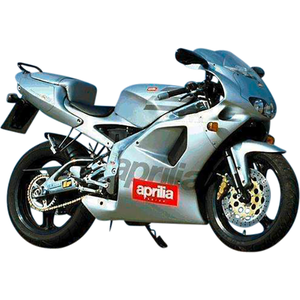Aprilia RS 250 [1994–1997]: A Two-Stroke Symphony Revisited
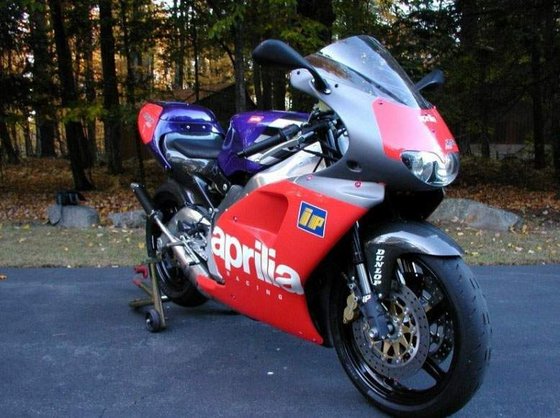
Introduction
The Aprilia RS 250 isn’t just a motorcycle—it’s a time capsule from an era when two-stroke engines ruled the racetracks and Italian design dared to defy convention. Produced between 1994 and 1997, this machine remains a cult classic, blending Grand Prix-inspired engineering with road-legal practicality. Limited to just 500 units for its Loris Reggiani and Chesterfield Replica editions, the RS 250 is as much a collector’s item as it is a thrill machine. But what’s it like to ride this pocket-sized rocket today? Let’s twist the throttle and find out.
Design: A Masterclass in Italian Flair
From the moment you lay eyes on the RS 250, its race-bred DNA is unmistakable. The twin side-mounted expansion chambers, the polished aluminum “banana” swingarm, and the aggressive, wind-cheating fairing all scream performance. The twin-spar aluminum frame, developed in collaboration with Benelli, isn’t just lightweight (141 kg / 309 lbs dry weight)—it’s a work of art. Even the mirrors, often an afterthought on sportbikes, blend seamlessly into the aerodynamic profile.
The cockpit is minimalist but purposeful. The LCD dash (a novelty in the ’90s) includes a lap timer—a cheeky nod to its track ambitions. The seat height (810 mm / 31.9 in) is surprisingly accessible, though the rearset pegs and clip-on bars leave no doubt: this bike means business.
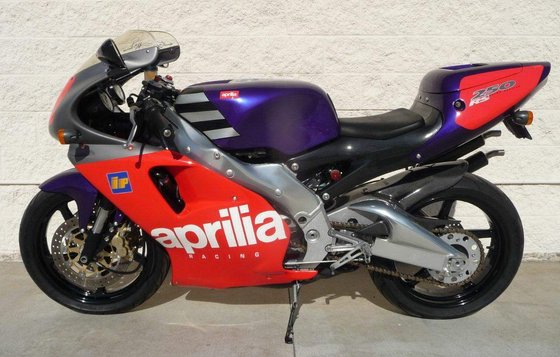
Engine & Performance: The Two-Stroke Scream
At its heart lies a modified Suzuki RGV250 (VJ22) engine, but Aprilia didn’t settle for stock. Reprogrammed ignition, redesigned cylinders, and expansion chambers boost output to 72.5 hp at 11,900 rpm—a staggering figure for a 249cc V-twin. The catch? This engine lives at the edge of its powerband. Below 8,000 rpm, it’s docile, even asthmatic. But cross that threshold, and the RS 250 transforms. The exhaust note sharpens into a metallic wail, and acceleration pins you to the tank.
Riding this bike is a lesson in commitment. Keep the revs between 9,000 and 12,000 rpm, and you’ll hit 130 mph (209 km/h)—a number that still embarrasses modern 300cc four-strokes. The 6-speed gearbox, lifted from the RGV, has wide ratios, demanding precise shifts to stay in the “zone.” It’s exhausting, exhilarating, and utterly addictive.
Handling: Precision Meets Playfulness
The RS 250’s chassis is its crowning achievement. The inverted 40 mm Showa forks (adjustable for rebound and compression) and Sachs monoshock rear (tunable for preload and damping) strike a rare balance between track stiffness and road compliance. Throw it into a corner, and the bike carves like a scalpel. The 17-inch wheels (110/70 front, 150/60 rear) offer grip that feels telepathic, even by modern standards.
Braking is equally impressive. Dual 298 mm Brembo discs with 4-piston calipers up front deliver bite that’s almost too sharp—stomp the lever too hard, and the rear wheel lifts. But on track, where fade is the enemy, these anchors inspire confidence lap after lap.
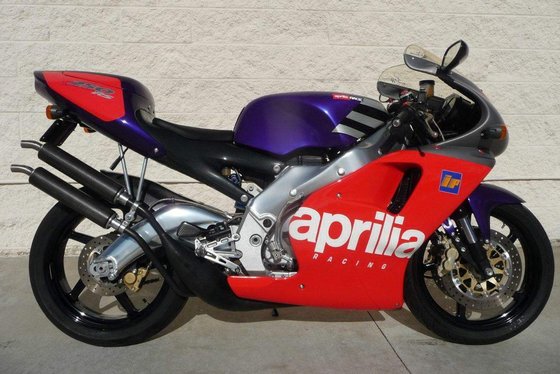
Competition: How Does It Stack Up?
In the ’90s, the RS 250 faced fierce rivals:
- Suzuki RGV250 Gamma: The RS’s donor engine, but with 8 hp less and a steel frame. The RGV feels more compact but lacks the Aprilia’s adjustability and premium finish.
- Honda NSR250: Another two-stroke legend, the NSR offered Honda reliability but couldn’t match the RS’s chassis sophistication.
- Kawasaki ZXR400: A 4-cylinder four-stroke with smooth power delivery. Heavier (183 kg / 403 lbs) and slower, but easier to live with daily.
Today, the RS 250’s closest analog is the Yamaha YZF-R3—a bike that trades raw power for usability. But for purists, nothing replicates the RS’s manic energy.
Maintenance: Keeping the Legend Alive
Owning an RS 250 isn’t for the faint-hearted. Two-stroke engines demand meticulous care:
- Oil: Use high-quality synthetic 2T oil (ISO-L-ETC++ or API TC++ specs). The separate lubrication system is reliable, but skimping here risks seizures.
- Carburetors: The Mikuni 34mm flatslides gum up if left unused. Clean them annually and consider ethanol-resistant gaskets.
- Cooling: Replace coolant every two years. Overheating warps the cylinders—a costly fix.
- Tyres: Stick to period-correct sizes (110/70-17 front, 150/60-17 rear). Modern rubber like Pirelli Diablo Rosso III improves grip without altering character.
- Spark Plugs: NGK BR9ECM plugs (gap 0.7–0.8 mm) are critical for smooth high-RPM operation.
At MOTOPARTS.store, we stock OEM-spec chains (DID 520V6), Brembo brake pads, and NGK plugs to keep your RS 250 screaming.
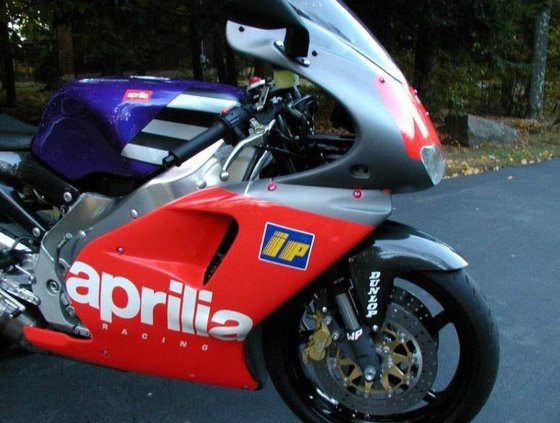
Conclusion: A Love Letter to Enthusiasts
The Aprilia RS 250 isn’t just a motorcycle—it’s a rebellion against compromise. It’s raw, demanding, and unapologetically niche. For riders willing to dance on the razor’s edge of its powerband, few bikes deliver such visceral rewards. And with MOTOPARTS.store’s curated selection of parts, keeping this Italian icon alive has never been easier.
So, is the RS 250 a practical daily rider? No. Is it a masterpiece of 90s engineering? Absolutely.
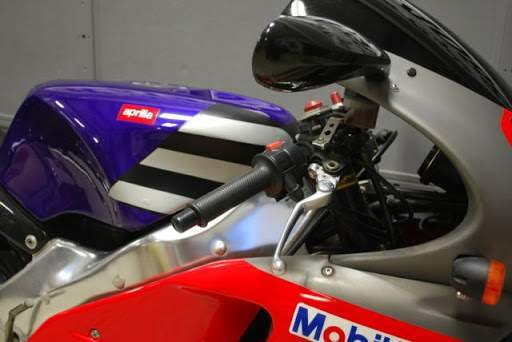
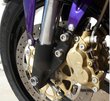











Specifications sheet
| Engine | |
|---|---|
| Stroke: | Two-stroke |
| Ignition: | CDI |
| Max power: | 53 kW | 71.0 hp |
| Max torque: | 40 Nm |
| Fuel system: | 2 x 34 mm Mikuni 34 SS flat side carburetors |
| Lubrication: | Oil pump with separate circuit |
| Max power @: | 11900 rpm |
| Displacement: | 249 ccm |
| Max torque @: | 10750 rpm |
| Configuration: | V |
| Cooling System: | Liquid cooled |
| Starting system: | Kick |
| Compression ratio: | 12.0:1 |
| Number of cylinders: | 2 |
| Engine oil recommendation: | IP MAX 2T COMPETITION or API TC++/ISO-L-ETC++ |
| Dimensions | |
|---|---|
| Wheelbase: | 1370 mm (53.9 in) |
| Dry weight: | 141 |
| Wet weight: | 167 |
| Seat height: | 810 mm (31.9 in) |
| Fuel reserve: | 3.5 L (0.9 US gal) |
| Overall width: | 690 mm (27.2 in) |
| Overall height: | 1080 mm (42.5 in) |
| Overall length: | 1880 mm (74.0 in) |
| Ground clearance: | 135 mm (5.3 in) |
| Fuel tank capacity: | 16.5 L (4.4 US gal) |
| Drivetrain | |
|---|---|
| Clutch: | Oil bath, multiple-disc |
| Final drive: | chain |
| Gear ratios: | {'1st': '11:27 (1:2.454)', '2nd': '16:26 (1:1.625)', '3rd': '17:21 (1:1.235)', '4th': '22:23 (1:1.045)', '5th': '24:22 (1:0.916)', '6th': '25:21 (1:0.840)'} |
| Chain length: | 110 |
| Transmission: | 6-speed, direct drive |
| Rear sprocket: | 42 |
| Front sprocket: | 14 |
| Primary reduction: | 23:59 (1:2.565) |
| Maintenance | |
|---|---|
| Brake fluid: | DOT 4 |
| Gearbox oil: | SAE 75W-90 (API GL-4) |
| Spark plugs: | NGK BR9ECM |
| Spark plug gap: | 0.8 |
| Coolant capacity: | 1.9 |
| Forks oil capacity: | 0.84 |
| Gearbox oil capacity: | 0.7 |
| Engine oil change interval: | N/A (2-stroke oil injection) |
| Gearbox oil change interval: | Every 5000 km or annually |
| Recommended tire pressure (rear): | 2.1 bar (30.5 psi) solo / 2.3 bar (33.4 psi) loaded |
| Recommended tire pressure (front): | 1.9 bar (27.6 psi) solo / 2.1 bar (30.5 psi) loaded |
| Performance | |
|---|---|
| Top speed: | 209.5 km/h (130.2 mph) |
| Standing ¼ mile: | 12.50 sec @ 172.5 km/h (107.2 mph) |
| Chassis and Suspension | |
|---|---|
| Rake: | 25° |
| Frame: | Aluminum twin-spar with magnesium alloy swingarm |
| Rear tire: | 150/60-17 |
| Front tire: | 110/70-17 |
| Rear wheel: | 4.50 x 17 |
| Front wheel: | 3.00 x 17 |
| Rear brakes: | 220 mm disc, 2-piston caliper |
| Front brakes: | 2 x 298 mm discs, 4-piston Brembo calipers |
| Rear suspension: | Monoshock with reservoir, adjustable preload/compression/rebound |
| Front suspension: | 40 mm inverted fork, adjustable rebound/compression damping |
| Rear wheel travel: | 130 mm (5.1 in) |
| Front wheel travel: | 120 mm (4.7 in) |



